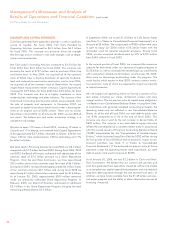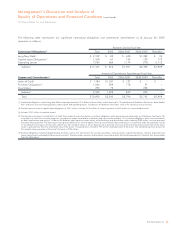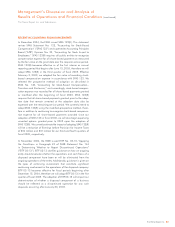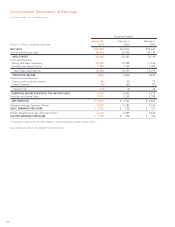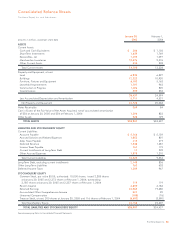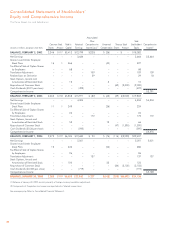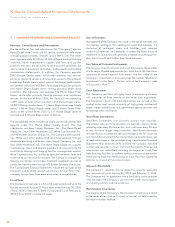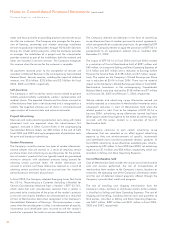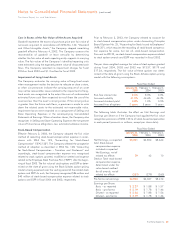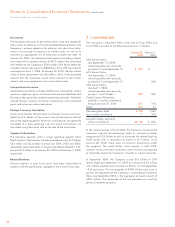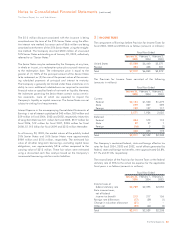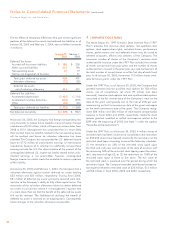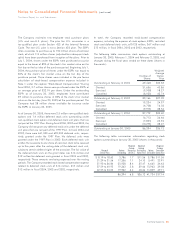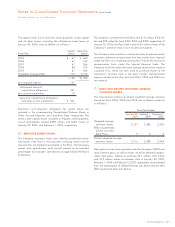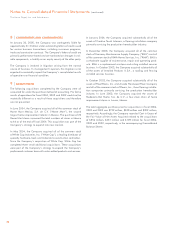Home Depot 2004 Annual Report Download - page 31
Download and view the complete annual report
Please find page 31 of the 2004 Home Depot annual report below. You can navigate through the pages in the report by either clicking on the pages listed below, or by using the keyword search tool below to find specific information within the annual report.
Notes to Consolidated Financial Statements (continued)
The Home Depot, Inc. and Subsidiaries
29The Home Depot, Inc.
Certain subsidiaries and distribution centers record Merchandise
Inventories at the lower of cost (first-in, first-out) or market, as deter-
mined by the cost method. These Merchandise Inventories represent
approximately 11% of the total Merchandise Inventories balance.
Independent physical inventory counts are taken on a regular basis
in each store and distribution center to ensure that amounts
reflected in the accompanying Consolidated Financial Statements
for Merchandise Inventories are properly stated. During the period
between physical inventory counts, the Company accrues for
estimated losses related to shrink on a store by store basis based
on historical shrink results and current trends in the business. Shrink
is the difference between the recorded amount of inventory and the
physical inventory. Shrink (or in the case of excess inventory,
“swell”) may occur due to theft, loss, improper records for the
receipt of inventory or deterioration of goods, among other things.
Income Taxes
The Company provides for federal, state and foreign income taxes
currently payable, as well as for those deferred due to timing
differences between reporting income and expenses for financial
statement purposes versus tax purposes. Federal, state and foreign
tax benefits are recorded as a reduction of income taxes. Deferred
tax assets and liabilities are recognized for the future tax conse-
quences attributable to differences between the financial statement
carrying amounts of existing assets and liabilities and their respec-
tive tax bases. Deferred tax assets and liabilities are measured
using enacted income tax rates expected to apply to taxable
income in the years in which those temporary differences are
expected to be recovered or settled. The effect of a change in
income tax rates is recognized as income or expense in the period
that includes the enactment date.
The Company and its eligible subsidiaries file a consolidated U.S.
federal income tax return. Non-U.S. subsidiaries and certain
U.S. subsidiaries, which are consolidated for financial reporting
purposes, are not eligible to be included in the Company’s consol-
idated U.S. federal income tax return. Separate provisions for
income taxes have been determined for these entities.
The American Jobs Creation Act of 2004 (“AJC Act”) provides a
one-time 85 percent dividends-received deduction that would apply
to qualified cash dividends received from controlled foreign corpo-
rations if the funds are reinvested in the U.S. The deduction can
result in an effective income tax rate of 5.25 percent on the repa-
triation of foreign earnings, a rate much lower than the normal
statutory income tax rate of 35 percent. At this time, the Company
is evaluating whether some or all of its unrepatriated foreign earn-
ings will be repatriated under this new law. Since the Company
currently intends to reinvest the unremitted earnings of its non-U.S.
subsidiaries and postpone their remittance indefinitely, no provision
for U.S. income taxes for non-U.S. subsidiaries was recorded in the
accompanying Consolidated Statements of Earnings.
The AJC Act also provides a new deduction for qualified domestic
production activities. When fully phased-in, the deduction will be up
to nine percent of the lesser of qualified production activities
income or taxable income. Pursuant to Statement of Financial
Accounting Standards (“SFAS”) No. 109, “Accounting for Income
Taxes,” the deduction will be accounted for as a special deduction,
not as a tax-rate reduction, because the deduction is contingent
on performing activities identified in the AJC Act. The Company is
currently assessing the potential impact of the AJC Act on its
Provision for Income Taxes.
Depreciation and Amortization
The Company’s Buildings, Furniture, Fixtures and Equipment are
depreciated using the straight-line method over the estimated
useful lives of the assets. Leasehold Improvements are amortized
using the straight-line method over the original term of the lease
or the useful life of the improvement, whichever is shorter.
The Company’s Property and Equipment is depreciated using the
following estimated useful lives:
Life
Buildings 10–45 years
Furniture, Fixtures and Equipment 3– 20 years
Leasehold Improvements 5– 30 years
Capitalized Software Costs
The Company capitalizes certain costs related to the acquisition
and development of software and amortizes these costs using the
straight-line method over the estimated useful life of the software,
which is three years. These costs are included in Furniture, Fixtures
and Equipment in the accompanying Consolidated Balance Sheets.
Certain development costs not meeting the criteria for capitalization
are expensed as incurred.
Revenues
The Company recognizes revenue, net of estimated returns, at the
time the customer takes possession of merchandise or receives serv-
ices. The liability for sales returns is estimated based on historical
return levels. When the Company receives payment from customers
before the customer has taken possession of the merchandise or the
service has been performed, the amount received is recorded as
Deferred Revenue in the accompanying Consolidated Balance
Sheets until the sale or service is complete.
Services Revenue
Net Sales include services revenue generated through a variety of
installation and home maintenance programs. In these programs,
the customer selects and purchases material for a project and the
Company provides or arranges professional installation. These
programs are offered through Home Depot and EXPO Design Center



